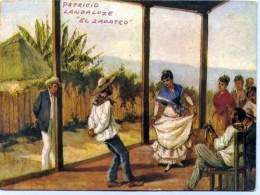It is a dance of Spanish origin. Arisen in rural areas, it is believed that, as early as 1550 , the first colonizers began to develop a fondness for dances whose main attraction was the shuffling of feet or zapateado, of possible Andalusian origin, which is found in some influential dances. Celtic in Europe . Other historians and researchers attribute a Canarian root to it.

History
In Latin America, many other folk dances present the same influences, such are the cases of the Mexican syrup, the Venezuelan joropo and the Chilean cuecas. According to Alejo Carpentier , in his book Music in Cuba , the first signs of the appearance of zapateo date from the early 18th century , although it was not until the second half of the 19th century that it reached its peak, to remain in force until the first two decades of the twentieth century , when it became a historical dance of the Cuban cultural heritage, although it is still danced in peasant regions of Cuba.
The Zapateo
The zapateo is a loose couple dance, which is supported by the music in a six-by-eight measure, the singing and the clapping of the participants. The woman stands upright and holds her apron or skirt with both hands; the man leans forward slightly with his arms crossed behind at the hips, so that he pretends to chase the body of the partner with his head, as the rooster does with the hen during the wedding procession. She provokes him and he finishes the dance by placing his hat on her head or his scarf on her shoulders.
characteristics
The most notable characteristic of the zapateo dance is the play of the feet, with the alternating toe and heel to carry the rhythm, the basic step that gives the dance its name. The man turns around the woman, who tries not to turn her back on him, so she turns on her own axis, accentuating the masculine courtship and feminine flirtation. The choreographic drawings are free and spontaneous, and other steps known as brushing and flourishing are presented, the latter of which can be performed, equally, quickly or slowly.
Modalities
According to Caridad Santos Gracia and Nieves de Armas Rigal , there are still five regional modalities in the way of interpreting this dance:
- Zapateo Camagueyano , province of Camagüey
- Zapateo de Florida , Florida municipality , Camagüey province
- Zapateo de Najasa , Najasa municipality , Camagüey province
It should be clarified that they all have similarities in steps and positions.
